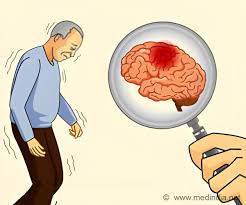Parkinsonism is a slowly progressing disease involving primarily a degeneration of cells in basal ganglia and substantia nigra causes deficiency of dopamine that often impairs the motor skills, speech and other functions of the patient.
The main symptoms include tremors, slowness of movement (bradykinesia), muscle stiffness (rigidity), and difficulty with balance and coordination.
Etiology of parkinsonism
- Idiopathic
- Multi-infarct artherosclerosis
- Viral infection(encephalitis lethargica)
- Chemical toxicity(Manganease,Carbondisulphide,Carbon monoxide etc)
- Drug induced parkinsonism (Phenothiazines, butryophenones)
- Metabolic causes(abnormal calcium metabolism)
Pathology
Neurodegeneration: Due to degeneratin of the cells in besal ganglia and substantia nigra , dopamine(responsible for coordination of movement) normal level is decreased.Because of decrease in the striatum( dopamine receptors in basal ganglia) are not adequately stimulated.This causes decreased or absent inhibitory influence causing excessive excitation of the extra pyramidal system.
Lewy Bodies: In Parkinson’s disease and some other forms of Parkinsonism, abnormal protein deposits called Lewy bodies accumulate within certain nerve cells in the brain. These Lewy bodies are primarily composed of alpha-synuclein protein and are thought to contribute to the neurodegenerative process and subsequent motor symptoms.
Clinical features of parkinsonism
The clinical features of parkinsonism vary depending on the underlying cause but generally include a combination of motor and non-motor symptoms. Here’s a breakdown of the typical clinical features:

Motor Symptoms:
- Tremor: Typically a resting tremor, which means it occurs when the affected limb is at rest and diminishes with voluntary movement.
- Bradykinesia: Slowness of movement, which can affect various activities such as walking, writing, or performing fine motor tasks.
- Muscle Rigidity: Stiffness or resistance to passive movement of the limbs, often described as “cogwheel rigidity” due to the jerky quality when the limb is moved.
- Postural Instability: Difficulty with balance and coordination, which can lead to frequent falls, especially in later stages of the disease.
- Autonomic Dysfunction: Includes problems with blood pressure regulation, digestion, sweating, and sexual function.
- Cognitive Changes: Mild cognitive impairment may occur early in the disease, and some individuals may later develop dementia, especially in certain forms of parkinsonism like Lewy body dementia.
- Sleep Disturbances: Such as insomnia, vivid dreams or nightmares, restless legs syndrome, daytime sleepiness.
- Psychiatric Symptoms: Depression and anxiety are common, along with hallucinations and delusions in some cases, particularly in Lewy body dementia.
- Speech and Swallowing Difficulties: Reduced voice volume (hypophonia), slurred speech, and difficulty swallowing (dysphagia) may occur.
Management
Medical management
- Levodopa
- Dopamine agonist
- Amantadine
- Anticholinergics
- Selegiline
Physiotherapy management
For patients with Parkinson’s disease , the main objective of the physiotherapy is to improve the quality of life by maintaining or increasing patient’s functional independence, safety and well being. Here are some key aspects of physiotherapeutic management for Parkinson’s disease:
- Exercise Programs: Tailored exercise programs are designed to improve flexibility, strength, balance, and coordination. Examples include stretching exercises, aerobic activities, resistance training, and activities that promote agility and coordination.
- Gait Training: Since Parkinson’s disease can affect walking ability, gait training focuses on improving stride length, step height, and walking speed. Techniques may include cueing strategies (like visual or auditory cues), practicing dual tasks (walking while performing another task), and practicing walking on different surfaces.
- Balance Training: Balance exercises help reduce the risk of falls, a common concern in Parkinson’s disease. These exercises may involve weight shifting, standing on one leg, using balance boards or stability balls, and practicing functional tasks that challenge balance.
- Posture Correction: Physiotherapists work on improving posture to minimize stooped or slouched positions, which can contribute to stiffness and discomfort. Exercises and techniques to promote upright posture and body awareness are often used.
- Manual Therapy: Hands-on techniques such as joint mobilizations and soft tissue mobilizations may be used to alleviate muscle stiffness and improve joint range of motion.
- Education and Counseling: Physiotherapists provide education on Parkinson’s disease symptoms, the importance of exercise, and strategies for managing daily activities more effectively. They may also offer advice on home exercises and adaptations.
- Speech and Swallowing Therapy: Some physiotherapists specialize in speech therapy and can provide exercises and strategies to improve speech clarity and swallowing function, which can be affected in Parkinson’s disease.
- Assistive Devices and Equipment: Physiotherapists can recommend and teach the use of assistive devices such as canes, walkers, or orthotics to improve mobility and safety.
- Long-Term Management: Parkinson’s disease is progressive, so physiotherapy involves long-term planning to adapt exercises and strategies as the disease changes over time.
- Collaboration with Other Health Professionals: Physiotherapists often work closely with neurologists, occupational therapists, speech therapists, and other healthcare providers to ensure a comprehensive approach to managing Parkinson’s disease.
Overall, physiotherapy aims to empower individuals with Parkinson’s disease to maintain independence, manage symptoms effectively, and improve their overall quality of life. The specific interventions used will vary based on the individual’s symptoms, functional abilities, and goals of therapy.
What is the primary cause of Parkinsonism?
Parkinsonism is primarily caused by the degeneration of cells in the basal ganglia and substantia nigra, leading to a deficiency of dopamine.
How does physiotherapy help in managing Parkinson’s disease?
Physiotherapy helps improve quality of life by focusing on exercises for flexibility, strength, balance, and coordination, as well as gait and posture training.

